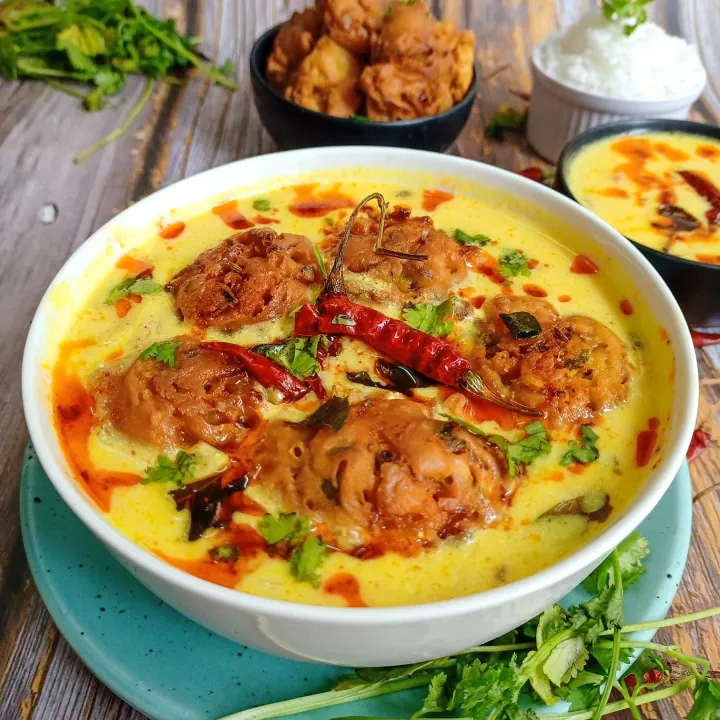Kadhi Pakoda Recipe: The Punjabi Kadhi Pakoda is richly flavored with an array of spices, ranging from cloves and cinnamon to fenugreek and coriander seeds. The addition of pakoras enhances its appeal, making it irresistible.
Ensure to simmer the Punjabi Kadhi Pakoda for just a minute or two after adding the pakoras to allow them to absorb the flavors without becoming soggy.
Notes and Important Tips for Punjabi Kadhi Pakoda Recipe:
- Sieve the besan before using it to avoid grainy particles, as it is the main ingredient for the pakoras.
- Add water gradually while making the batter to achieve a medium consistency. Too much water will result in shapeless pakoras, while too little water will yield a thick batter.
- Fry the pakoras in hot oil to attain a golden brown color and proper texture.
- Allow the kadhi to simmer for 8 to 10 minutes on a slow flame to eliminate the raw taste of besan and curd.
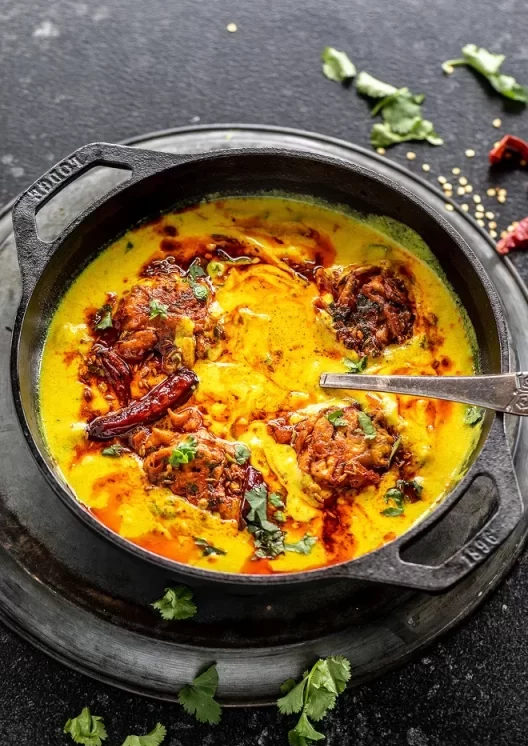
Kadhi Pakoda Recipe Ingredients:
For the Pakoras:
- 1 cup besan (bengal gram flour)
- 2 tbsp finely chopped coriander
- 1/4 cup finely chopped onions
- 1 tsp chilli powder
- 1 tsp coriander powder
- 1/4 tsp turmeric powder
- 1 tsp cumin seeds
- 1 tsp finely chopped green chillies
- Salt to taste
- Oil for deep-frying
For the Kadhi:
- 1 1/2 cups curd (yogurt)
- 3 tbsp besan (bengal gram flour)
- 1/4 tsp turmeric powder
- Salt to taste
- 1 tbsp oil
- 1/2 tsp cumin seeds
- 2 cloves
- 1 small stick cinnamon
- 1/4 tsp fenugreek seeds
- 1/2 tsp coriander seeds
- 2 whole dry kashmiri red chillies, broken into pieces
- 1 tsp ginger-green chilli paste
- 1/2 tsp chilli powder
- 1 1/4 cups fried onions
For Garnish:
- 2 tbsp finely chopped coriander
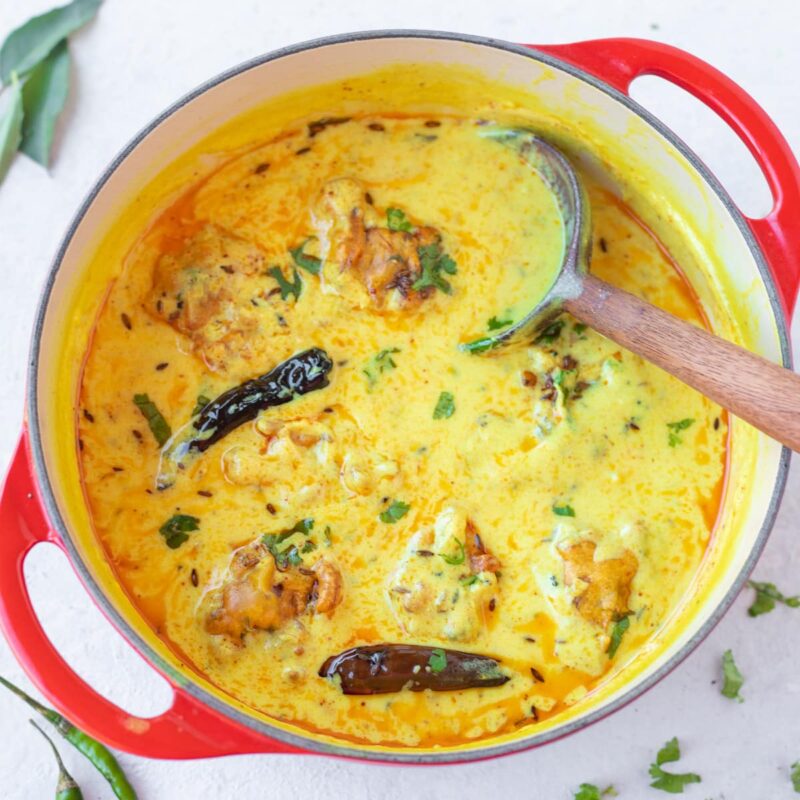
Kadhi Pakoda Recipe Method:
For the Pakoras:
- Combine all the ingredients with approximately 1/4 cup of water in a deep bowl to make a thick batter.
- Heat oil in a deep non-stick pan and fry spoonfuls of the batter till golden brown. Drain on absorbent paper and set aside.
For the Kadhi:
- Whisk together curd, besan, turmeric powder, salt, and 2 cups of water in a deep bowl.
- Heat oil in a deep non-stick pan and sauté cumin seeds, cloves, cinnamon, fenugreek seeds, coriander seeds, and dry red chillies.
- Lower the flame, add the curd-besan mixture, ginger-green chilli paste, chilli powder, and salt. Cook on a slow flame for 8 to 10 minutes, stirring occasionally.
To Proceed:
- Reheat the kadhi, add fried onions, and cook for 2 minutes.
- Add the pakoras, mix gently, and cook for 5 minutes.
- Serve hot, garnished with chopped coriander.
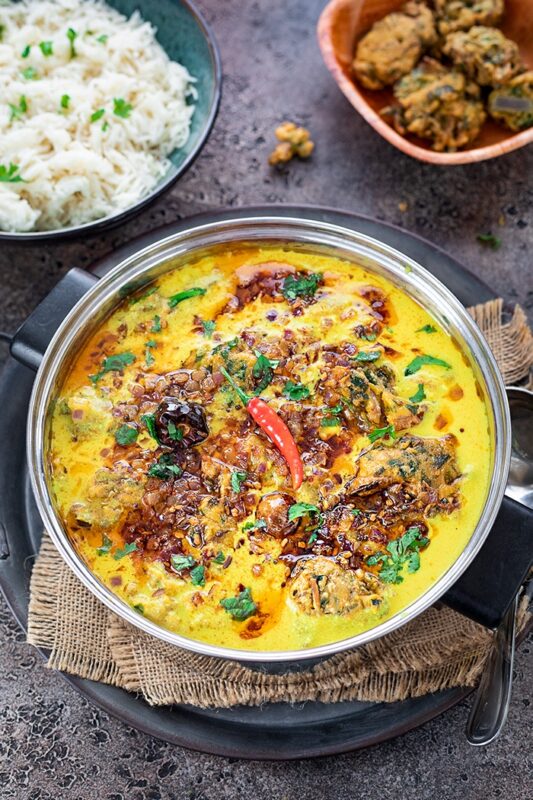
Nutrient values per serving:
- Energy: 276 cal
- Protein: 10.1 g
- Carbohydrates: 24.2 g
- Fiber: 5.4 g
- Fat: 13.8 g
- Cholesterol: 10.7 mg
- Sodium: 38.7 mg
Tips for Punjabi Kadhi Pakoda Recipe:
- When preparing the batter for pakodas, put the besan in a deep bowl. Sieving the besan before use helps avoid grainy particles, ensuring a smoother texture for the pakodas in the Punjabi Kadhi Pakoda.
- Gradually add approximately 1/4 cup of water to the besan. Adding water little by little is crucial as too much water will result in a thin batter, leading to shapeless pakoras that may fall apart during frying. Conversely, too little water will yield a thick batter, resulting in a raw taste after frying. Aim for a medium consistency batter, neither too thick nor too thin.
- When frying the pakodas, heat the oil in a deep non-stick pan and drop spoonfuls of the batter into the hot oil. Fry a few pakodas at a time on a medium flame. Ensure the oil is sufficiently hot, as frying the pakodas in hot oil yields a nice golden brown color and proper texture.
- After adding the curd-besan mixture to the pan, mix well and cook on a slow flame for 8 to 10 minutes. Stir occasionally during this process. Allowing the kadhi to simmer ensures that the rawness of the besan and curd dissipates, enhancing the overall flavor of the dish.
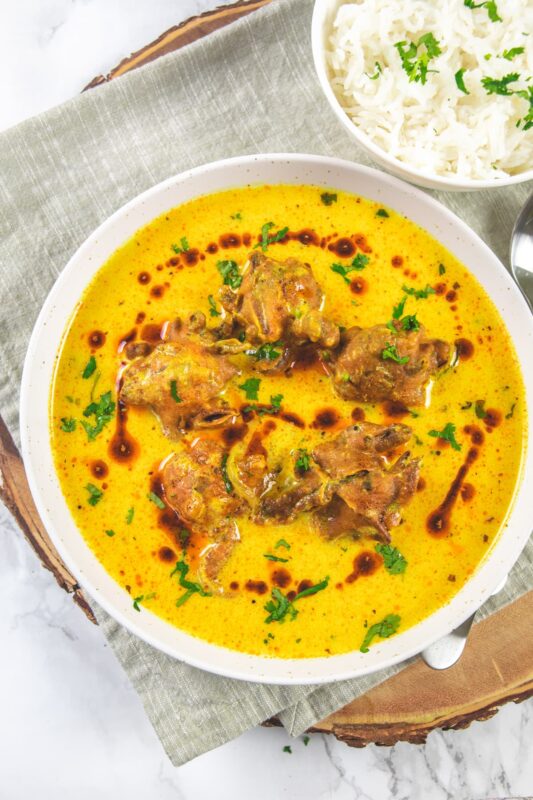
Conclusion:
The Punjabi Kadhi Pakoda Recipe is a flavorful and comforting dish that combines aromatic spices with crispy pakoras in a rich and creamy gravy. By following the tips provided and understanding the key steps in the recipe, you can create a delicious and authentic Punjabi dish that is sure to impress your family and friends. Enjoy this hearty meal as a wholesome lunch or dinner option!
FAQs about Punjabi Kadhi Pakoda Recipe:
Why is it important to sieve the besan before using it for pakoras?
Sieving the besan helps remove any grainy particles, resulting in a smoother texture for the pakodas in the Punjabi Kadhi Pakoda. This ensures a better overall eating experience.
How much water should be added to the besan when making the pakora batter?
It’s crucial to add water gradually, starting with approximately 1/4 cup. Adding too much water will result in a thin batter, leading to shapeless pakoras that may fall apart during frying. Conversely, too little water will yield a thick batter, resulting in a raw taste after frying. Aim for a medium consistency batter, neither too thick nor too thin.
What is the optimal frying technique for the pakoras?
When frying the pakoras, heat the oil in a deep non-stick pan and drop spoonfuls of the batter into the hot oil. Fry a few pakoras at a time on a medium flame. Ensure the oil is sufficiently hot, as frying the pakoras in hot oil yields a nice golden brown color and proper texture.
Why is it necessary to simmer the kadhi after adding the curd-besan mixture?
Simmering the kadhi allows the flavors to meld together and ensures that the rawness of the besan and curd dissipates. This enhances the overall flavor of the dish and ensures a well-cooked consistency.
How should the Punjabi Kadhi Pakoda be served?
The Punjabi Kadhi Pakoda is best served hot, garnished with chopped coriander. It pairs well with steamed rice or chapati and makes for a satisfying and flavorful meal.

